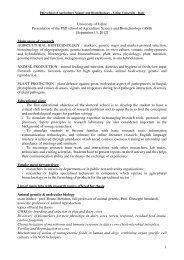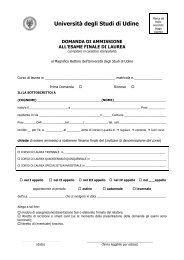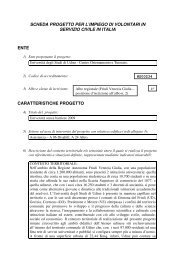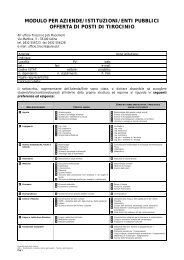â¢GUIDA ECONOMIA 07-08 - Università degli studi di Udine
â¢GUIDA ECONOMIA 07-08 - Università degli studi di Udine
â¢GUIDA ECONOMIA 07-08 - Università degli studi di Udine
Create successful ePaper yourself
Turn your PDF publications into a flip-book with our unique Google optimized e-Paper software.
prospectus pordenone<br />
259<br />
Two variable functions: level curves, surfaces<br />
and intersection with planes. Limits<br />
of two variable functions. First and second<br />
order partial derivatives. Optimisation<br />
of two variable functions. Constrained<br />
optimisation.<br />
Integrals: Riemann sums. Definite and<br />
indefinite integrals. Rules of integration.<br />
The fundamental theorem of calculus.<br />
Improper integrals.<br />
Bibliography<br />
Recommended rea<strong>di</strong>ngs<br />
- Theory and practical exercises provided<br />
by the lecturer.<br />
- R. ISLER, Matematica generale, e<strong>di</strong>zioni<br />
Goliar<strong>di</strong>che, Trieste.<br />
- L. PECCATI, S. SALSA, A. SQUELLATI,<br />
Matematica per l’Economia e per l’azienda,<br />
Egea, Milano 2004.<br />
- L. SCAGLIANTI, A. TORRIERO, Matematica.<br />
Meto<strong>di</strong> e applicazioni, Cedam.<br />
MATHEMATICS FOR FINANCE<br />
Prof. Nando Prati<br />
Contents<br />
First Part. Mathematics of finance fundamentals<br />
under certainty con<strong>di</strong>tions. Elementary<br />
financial transactions. Basic definitions:<br />
interest, <strong>di</strong>scount, final value,<br />
present value, rates, factors. Financial<br />
laws: homogeneity, uniformity, decomposability.<br />
Financial rules: simple interest,<br />
compound interest, simple <strong>di</strong>scount.<br />
Real rate of interest, nominal rate of<br />
interest, force of interest, capitalization<br />
factor and <strong>di</strong>scount factor. Equivalent<br />
rates. Spot and forward rates. The term<br />
structure of interest rates.<br />
Second Part. Taxonomy of annuities. Present<br />
and future value of various types of<br />
annuities (imme<strong>di</strong>ate-deferred, or<strong>di</strong>narydue,<br />
perpetuities, annuities payable k-<br />
thly). Loan amortization. Amortization<br />
schedule. Instalments. Amount of loan<br />
repaid. Interest repaid. Globally repaid<br />
debt. Outstan<strong>di</strong>ng principal. Amortization<br />
methods: at maturity, with constant<br />
amount of loan repaid, with constant<br />
instalments.<br />
Third Part. Projects under certainty. Net<br />
Present Value (N.P.V.) and Internal Rate<br />
(I.R.R.) of a project. Balance of a project<br />
and outstan<strong>di</strong>ng capital. Net Present<br />
Value decomposition in perio<strong>di</strong>c results.<br />
Uniqueness con<strong>di</strong>tions for internal rate.<br />
Investment and pure investment projects.<br />
Acceptance criteria for a single<br />
investment project. Choosing between<br />
two investment projects. Comparison<br />
between the Internal Rate of Return<br />
(I.R.R.) criterion and the Net Present<br />
Value (N.P.V.) criterion.<br />
Bibliography<br />
Recommended books<br />
- F. PRESSACCO, P. STUCCHI, Elementi <strong>di</strong><br />
Matematica Finanziaria, Cedam, Padova,<br />
20<strong>07</strong>.<br />
Other rea<strong>di</strong>ngs<br />
- F. CACCIAFESTA, Lezioni <strong>di</strong> matematica<br />
finanziaria classica e moderna, third e<strong>di</strong>tion<br />
revised, Giappichelli, Torino.<br />
MICROECONOMICS<br />
Prof. Renzo Turatto<br />
Contents<br />
The course provides an introduction to<br />
microeconomics. Microeconomics is the<br />
branch of economic theory which <strong>stu<strong>di</strong></strong>es<br />
economic systems starting from the<br />
behaviour of in<strong>di</strong>viduals. In particular,<br />
economic theory considers the interaction<br />
among in<strong>di</strong>viduals who maximize<br />
objective functions accor<strong>di</strong>ng to some criteria<br />
of economic rationality. Therefore,<br />
the main analytical tool used in this <strong>di</strong>scipline<br />
is <strong>di</strong>fferential calculus and the<br />
mathematical theory of optimization.<br />
Budget constraint (Chapter 2); Prefer-
















